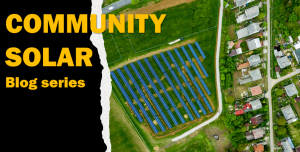Community Solar – Tracking the Maryland Legislation and Regulation
By David Comis, Senior Energy Program Manager
This is part five of a 7 part series on community solar.
Please note, the comments in this blog are the personal opinions of the author and do not represent the views of the Maryland Energy Administration or the State of Maryland.
The Maryland State Legislature adopted Community Solar legislation (Public Utility section 7-306.2) during its 2015 session. It directed a Community Solar Pilot Program of three years length, covering 1.5% of the state’s 2015 peak demand in megawatts (MW). In reality, the capacity allocations are specific to each utility and its 2015 peak demand. At present (July 2020), Community Solar Pilot Program tariffs are only in place for Potomac Edison, Pepco, Baltimore Gas and Electric (BGE), and Delmarva. If they desire, co-ops are authorized to submit a community solar tariff to the Maryland Public Service Commission (PSC) for approval.
The Maryland PSC adopted regulations for the program in July 2016 and approved community solar tariffs from the investor owned utilities in April 2017. Subscriber organization applications were accepted for review by the PSC in May 2017, with the initial assignment of pilot program solar capacity to approved subscriber organizations starting in June 2017. Utilities started accepting applications for interconnection agreements in June 2017.
During the 2019 legislative session, the Maryland General Assembly passed House Bill 683 which extended the pilot program from three years to seven years, and directed that the maximum capacity of the program be expanded (but did not provide a specific number for the new cap). On May 14, 2020, the Maryland PSC amended the Code of Maryland Regulations to enact the changes required by the law. The new regulations increased the total program capacity from 1.5% to 3.2% of the state’s 2015 peak demand. This equates to about 414 MW of community solar capacity available for allocation.
Community Solar capacity is split into three categories, with 40% designated for the Open category, 30% designated for the Small, Brownfields, and Other (SBO) category, and 30% designated for the Low-and-Moderate Income (LMI) category. For arrays receiving capacity in the Open category, the energy may be sold to anyone, residential or commercial. Arrays in the SBO category must be small (<500 kW-ac), on brownfields (e.g., a capped waste site), or other (a catch-all that includes rooftop units). Arrays in the LMI category must subscribe at least 10% of their energy to low income subscribers, with an additional 20% of their energy subscribed to either low or moderate income subscribers and the remaining 70% of the energy available for subscription by anyone.
The program regulations define a “low income” subscriber as a household which receives an income of less than or equal to 175% of the federal poverty level during a given year. “Moderate income” is defined as a household that receives an income of less than or equal to 80% of the state median income during a given year. On February 14, 2020, the Maryland PSC provided some guidance to help subscriber organizations validate the income of low and moderate income households. The guidance can be found on the Maryland PSC website under RM56 item 32 (see: https://webapp.psc.state.md.us/newIntranet/AdminDocket/NewIndex3_VOpenFile.cfm?FilePath=//Coldfusion/AdminDocket/RuleMaking/RM56//132.pdf )


 1-888-373-7888
1-888-373-7888 233733
233733